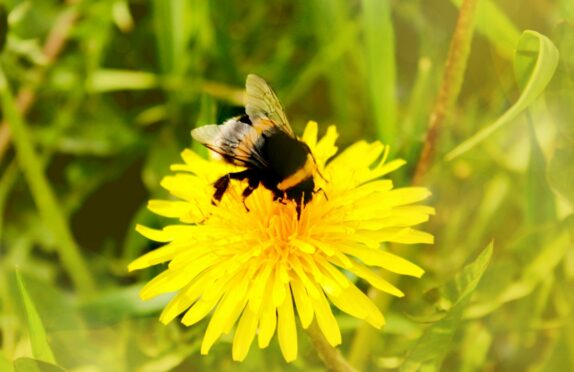
Albert Einstein reportedly warned: “If the bee disappeared, then man would have only four years of life left. No more bees, no more pollination, no more plants, no more animals, no more man.”
With the approach of spring in Scotland and the gradual reappearance of our bees, we should heed Einstein’s warning.
Over the past half century there has been a staggering decline in our bee population. A combination of factors have been blamed including the use of pesticides, habitat loss and the varroa mite, which sucks the blood from the honeybee and can spread viruses and disease in the hive, effectively killing the whole colony.
A dangerous cocktail of toxic chemicals used by farmers and gardeners to kill and control crop pests has also taken its toll on the bee population, as has climate change and fluctuating land use.
It is estimated that 97% of Britain’s wildflower-rich meadows have disappeared since the Second World War, leaving our bees and other pollinators desperately searching for food. The growth of cities, roads and railways, has removed swathes of hedgerows, meadows and wild spaces, causing a further crash in bee numbers.
The former rich, green pastures full of nectar-producing plants have in some parts of the UK become cereal deserts. Cereal crops like barley and wheat are pollinated by the wind and therefore bees don’t feed on them. Bees, confronted by vast strips of cereals when they leave their hives, become stressed and disease prone. They are forced to look elsewhere for food, without which the whole colony perishes.
Many people think that bees are simply good for making honey. That bees provide us with honey is certainly true and honey is a highly nutritious and wholly natural wonder food.
But bees are far more important than that.
They are a vital part of our ecosystem and are essential to our survival. Almost 70% of global food crops require pollination.
As Albert Einstein pointed out, with no bees we would be forced to live without products such as flowers, nuts, soya beans, onions, carrots, broccoli, sunflowers, apples, oranges and much, much more. Alfalfa, used for cattle feed is also dependent on the honeybee which would mean a fall in meat production. Certain medicinal plants and cotton rely on insect pollinators.
Worldwide, 90 commercial crops require pollination to survive. If the bees go, mankind might follow soon after.
There is already a part of China experiencing life without bees. The uncontrolled use of pesticides is said to have killed off the bees in an area of southern Sichuan. The pear trees, which are famous in this part of China, now have to be pollinated by hand. Pesticides were blamed in China, but what is causing the disappearance of bees in Scotland?
Scientists say bee colonies are under stress. Changing climate, poor air quality, monoculture, and the over-use of some toxic chemicals, have all taken their toll on bee health. A stressed or unhealthy bee is more susceptible to disease and to the increasingly prevalent varroa mite.
The Scottish Wildlife Trust urge us to plant bee friendly flowers, like daisies and allium; allow parts of our garden to grow wild, boosting growth of plants that normally would be considered weeds but are excellent sources of pollen and nectar; and limit the use of insecticides.
Farmers could help too by sowing small strips of land with crops such as the exotic flower phacelia, together with borage, charlock, wild white clover and other nectar-rich plants, creating a haven not only for bees, but for birds and other animals and insects, benefiting the whole ecosystem.
The loss of bees is a looming crisis for all of us. Probably the most fundamental link in the food chain, the honeybee is fast becoming the weakest.
Struan Stevenson, a former Member of the European Parliament, is a director of the environmental organisation, the European Bureau for Conservation and Development

Enjoy the convenience of having The Sunday Post delivered as a digital ePaper straight to your smartphone, tablet or computer.
Subscribe for only £5.49 a month and enjoy all the benefits of the printed paper as a digital replica.
Subscribe